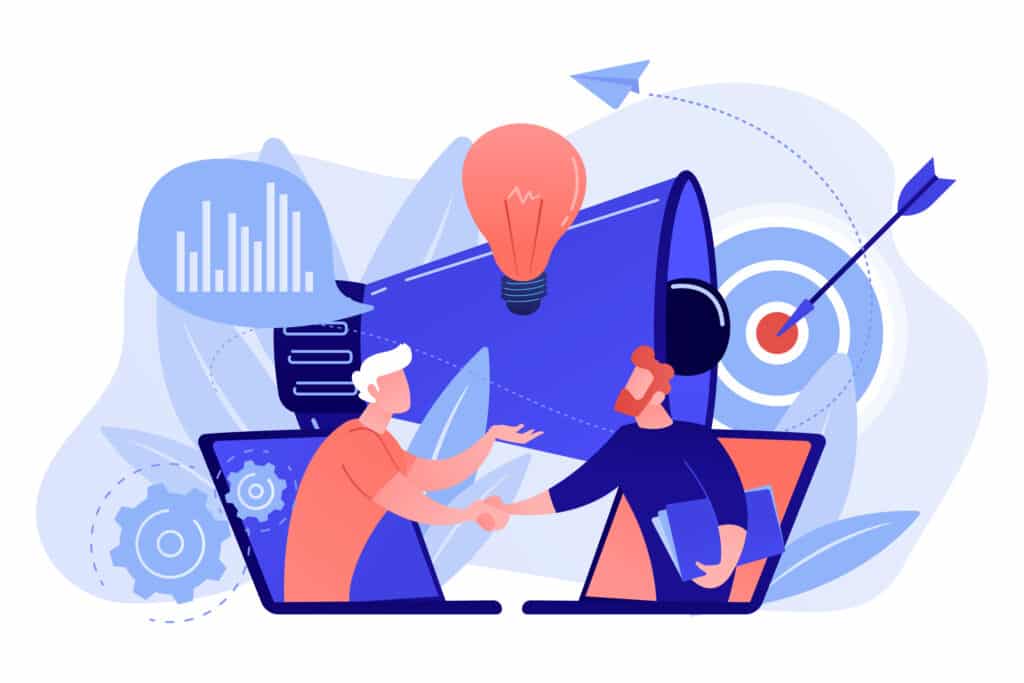Team Collaboration 101: What It Is and How to Improve It
Team collaboration is full of benefits for employees, workplaces, and companies overall. If you’re figuring out how to start collaborating or if you’ve been practicing it for a while, there’s always room for improvement. Keep reading for our tips, best practices, and recommended tools for team collaboration!
Table of Contents
Benefits of Team Collaboration
Challenges of Team Collaboration
How to Improve Team Collaboration
Team Collaboration Best Practices

What is team collaboration?
Team collaboration happens when individuals come together to produce or create something. Seems simple, right? But more than just “teamwork” where employees with similar skills work together, collaboration involves people with different skill sets working as a team to make something that none of them could have created on their own.
This kind of work is great for creative projects, problem-solving, and even brainstorming. It can bring different departments in your office together and can be a healthy challenge for employees to grow! Collaboration will stretch your team, and there might be some challenges along the way, but it’s worth it to produce the best version of something new.
Benefits of team collaboration
If you can start implementing team collaboration into your workflow, you’ll get to experience benefits for your team, your office culture, and your company overall. Some benefits that you can start looking for include better communication, boosted morale, higher employee motivation, higher employee retention rates, and greater leadership skills!
By using team collaboration on a regular basis, you can even increase employee engagement and will see employees who are sold out to the mission of your company. Because team collaboration entrusts employees to create and execute their projects without the hands-on help of a manager or superior, employees can feel that trust and responsibility on their shoulders. That feeling of being trusted leads employees to know that they have a major role to play in your organization.
This makes all the difference in employee engagement, which itself has some incredible benefits. If you want to create a healthy work culture with high levels of employee engagement, you should start using workflows such as team collaboration.

Team collaboration . . .
- Strengthens communication skills. As with any “team,” team collaboration involves communication, and a high level of it. Because team members are coming together from different areas of expertise, they need to be willing to clearly communicate to others who might not know what they know. For some, this will be an area of high growth, and for others, they’ll learn what it means to listen well as their coworkers explain something to them. Different forms of communication may improve, including writing and listening skills.
- Increases employee motivation. According to a study done at Stanford, people who collaborated on a team committed to working on their tasks 64% longer than those who were working on their own. Psychologically speaking, working on a team will increase your employees’ motivation to continue pushing forward in their work. There’s something about working together towards a common goal that encourages people to see a project through!
- Increases productivity and efficiency. As different employees work together, you’ll find that their collaboration can cut any slack that a one-person team would have had. By joining different expertises together, there’s no need to outsource and do extra research or learn new skills. In fact, employees can work on different parts of the project simultaneously, cutting down on the time it would take to complete something in a linear manner. (Of course some parts of your project might need to be completed in a linear order, but many times, employees can complete their individual tasks without needing help from others.)
- Builds team camaraderie. Similar to how team building can encourage unity amongst team members, collaboration can encourage camaraderie and stronger relationships across the office. As Dr. Rachel Maglinger said in Gallup’s Called to Coach webcast, “The heart of collaboration is, because I can’t be everything to everyone else, I need partners who supplement those things that get in my way.” In order to achieve the common goal, each team member must lean on the others to do certain tasks that are not in their repertoire. This kind of dependence strengthens relational connections, which makes for better teamwork overall.
- Boosts employee morale. Lead Grow Develop found several correlations between collaboration and increased morale, including how a better transfer of knowledge makes for more positive employees and how collaboration leads to employees supporting each other which leads to improved morale. Good morale isn’t just a nice catchphrase to have around the office, either. Forbes states that when morale is better, your business does better. More than anything, positive spirits in the workplace make for a work culture where your employees will continually want to show up.
- Improves leadership skills. Unlike the dynamics of teamwork, most team collaboration efforts don’t involve a hierarchy—each team member is equal to each other, and not one person calls the shots on what needs to be completed or even what the end goal might look like. Since each person must be able to manage themselves, stay motivated, and communicate well, their leadership skills naturally increase. Employees learn how to manage themselves individually, which easily can promote them to managing others well.
- Improves problem-solving skills. When you bring different people in to work on the same problem, they approach it with different points of view and experiences. Team collaboration allows employees to experience new ways of looking at and deciphering problems by learning from their peers. With each problem that comes up in the course of a project, each team member has an opportunity to grow and take new problem-solving skills to other areas of their jobs.
Team collaboration sounds like a dream, right? There are obvious wins for utilizing it in your workplace, so why wouldn’t we just jump right in?
The benefits listed above are available to you and your workplace, but sometimes they come after jumping over hurdles and maneuvering around obstacles. With patience and persistence, you’ll see the benefits emerge, but don’t be surprised by challenges that you may face.

Challenges of team collaboration
Keep in mind that as you embark on creating a work culture where collaboration happens more and more, there are some challenges that you might run into. These challenges differ depending on who’s working together, but with patience and the right people in place, you and your team can overcome them.
To give you a proper heads-up of the collaboration process, here are some common challenges (and solutions) that come with team collaboration:
- People work at different paces.
- Provide realistic deadlines for each task, relative to the employee who that task is assigned to. Employees should encourage each other throughout the process, no matter how quick or slow their teammates may be.
- Employees might struggle with their communication skills.
- Use different forms of communication and encourage frequent touch bases or meetings to ensure everyone is on the same page. Communication avenues can include in-person or virtual meetings, email, messaging features on management softwares, and quick one-on-one meetings.
- Team collaboration challenges how employees trust one another.
- Gather the right people who can collaborate well with one another. Your team should be composed of people with diverse skills and personality types, but know who would work well together and who would not. Also, check and double check that everyone knows what the end goal is and that they are bought into it!
- Virtual team collaboration creates both physical and communication gaps.
- Utilize an online team collaboration tool such as Slack or Asana so that team members can continue to communicate and stay on top of tasks and milestones. Virtual collaboration is possible and effective; as a manager, review our resources on managing virtual teams to best lead these kinds of teams.
- Employees can experience a lack of appreciation or feel overlooked.
- Even though team collaboration requires everyone to do their job, some roles might seem minuscule in comparison to others or misunderstood by others. At each touchpoint for the project, be sure to give credit where credit is due, and look for it in places that others might not see.
- Coworkers experience different levels of employee engagement.
- Take time to understand the importance of employee engagement and how you can increase it throughout your workplace. Disengaged coworkers might bring negativity to the team, which can slow down work and discourage others.
- Take time to understand the importance of employee engagement and how you can increase it throughout your workplace. Disengaged coworkers might bring negativity to the team, which can slow down work and discourage others.
Depending on your work environment, you may experience higher or lower versions of these challenges. The key to overcoming these challenges is to be willing to adapt how you work. Each team member might expect something different from their coworkers. As a project moves forward, adjustments will need to be made, and you might find yourself needing more clarity or communication. Again, with patience and persistence (and maybe some trial and error) you can get through these challenges and experience the benefits of team collaboration!

How to improve team collaboration
While staff and managers alike can benefit from team collaboration, it’s apparent that it’s still not a go-to for most teams. According to Queens University of Charlotte, almost 75% of employers say that collaboration is “very important,” yet 39% of employees around the world don’t believe there’s enough team collaboration happening at their companies.
So how can you improve team collaboration?
Implementing best practices such as celebrating milestones is a good place to start, but there are certain skills that each person must build for the best collaborative effort. One easy way to improve team collaboration is by using an online management tool that can keep your team on track. (Wrike, a collaboration management platform, found that 85% of employees that use these kinds of tools are happier!)
Keep reading for tips on best practices, skills to build, and a list of some of the best team collaboration tools!

Team collaboration best practices
Every company has room to improve when it comes to team collaboration. While the following tips might seem like a lofty goal for you and your team, begin implementing them one at a time so your team can grow in each one. Additionally, you can create a checklist of these practices (while even coming up with some of your own) and check each one off as you gather your employees into their collaborative workspace.
Here are some quick tips that will help you improve team collaboration in your company:
- Set clear goals. Clarifying goals will help your team stay on the same page throughout the project.
- Set attainable deadlines. Even if you have a time crunch, allowing your team the creative space they need to complete their work makes for the best collaboration.
- Over-communicate often. Because poor communication is one issue that hurts teams the most, encourage everyone to communicate in every step of the collaboration in multiple ways.
- Distribute work evenly. Give each person an opportunity to point at the end result and see where their contribution is.
- Provide safe brainstorming spaces. Allow your employees the time and comfort needed to come up with the best ideas for their projects.
- Encourage open communication and constructive feedback. As often as possible, let your team know that this is a team effort—everyone’s opinion matters, and you create the best results together.
- Highlight successes. Team collaboration can boost specifically positivity by calling out talents that each team member brings to the table. More positivity leads to better work and more motivation.
- Be flexible with deliverables and problem-solving. As teammates learn to work together and figure out their best work strategies, there will be trials and errors. Give them the space needed to work out work problems and adjust deadlines and deliverables as needed.
- Have the right software and tools available. The right equipment ensures that your team really can produce the best work possible.
- Lean into your employees’ strengths and skills. Collaborative teams are diverse, meaning there are a plethora of ways a certain project can go. Allow each employee to bring their best to the team.
- Focus on the action items of every team member. Make everyone aware of what roles they are expected to play throughout the duration of the project. This helps with communication and building realistic goals.
- Celebrate a job well done. This boosts morale and encourages team collaboration to happen again.

Team collaboration skills
There are certain skills that can help further your team collaboration efforts and improve the collaboration experience. You might find that one employee quickly picks up one skill but has trouble with another one, but that’s where the diversity of your team comes into play. It’s not imperative that everyone masters each of these skills, but it’s actually better—and more realistic—if coworkers can bring different skills to the table!
When you begin encouraging team collaboration in your office, you can encourage employees to work closely with people with different skills than themselves. This will allow them to be exposed to their own strengths and weaknesses, and weaknesses are not necessarily a bad thing! It can even help boost team camaraderie—each team member will see where they need others to succeed and will be encouraged to grow in their lane.
Skills that you will help improve team collaboration include:
- Communication
- How to build this skill:
- Implement different forms of communication (e.g., email, chat functions, forums, virtual meetings).
- Allow everyone a chance to speak.
- How to build this skill:
- Organization
- How to build this skill:
- Encourage employees to make to-do lists.
- Declutter workplaces and desks.
- How to build this skill:
- Open-mindedness
- How to build this skill:
- Ask ice breaker questions that can allow employees to open up about themselves and learn more about their coworkers. This will foster trust amongst employees which can help them stay open to suggestions and ideas.
- Share knowledge and allow for mistakes.
- How to build this skill:
- Flexibility
- How to build this skill:
- Begin brainstorming solutions when challenges or problems arise.
- Learn to expect the unexpected.
- Keep calm and carry on!
- How to build this skill:
- Creativity
- How to build this skill:
- Provide multiple opportunities for brainstorming sessions.
- Practice techniques for creative thinking such as storyboarding and picture prompts.
- Recognize and reward creative innovations.
- How to build this skill:
- Problem-solving
- How to build this skill:
- Encourage your team to play word or number puzzles such as crosswords and sudoku.
- Play the human knot game as a team.
- How to build this skill:
- Constructive feedback
- How to build this skill:
- Point out opportunities instead of faults.
- Focus on one or two things in whatever you’re giving feedback for.
- Be specific in what you are critiquing.
- How to build this skill:
Ultimately these skills and other workplace skills can be built through the right kinds of team building activities. Team building can take place virtually, in-person, on-site, or off-site, and you can even implement team building in everyday meetings in just ten minutes.

Best team collaboration tools
As your team comes together to start collaborating, you’ll want to make sure they can stay organized, that deliverables are clear, and that there are timelines for everything. In order to do that well, look into using tools or software to stay organized. Team collaboration tools and software are key pieces of the collaboration process!
There are a lot of different resources out there, so we’ve divvied up some online team collaboration tools by what’s free and what’s not. Of course, paying for software will get you more features and tools in a program. Consider a free trial of a program, and many companies will also work with your team specifically to figure out a product level that’s best for you!
Free online team collaboration tools
*Note that these products have extensive free versions but also offer paid versions that would be beneficial to larger or growing companies.
File-sharing tools
Multi-functional tools
Tools to boost communication
Tools to enhance team meetings
Paid online team collaboration tools
*These tools also have free versions and trials, but their best features are found in their paid plans.
Tools for better communication
Best Kanban boards for productivity and management

Start collaborating today!
No matter what kind of project you are working on or what industry you’re in, team collaboration is a great option for getting work done and improving your workplace! Your employees will experience benefits that will only come from working closely with coworkers and leaning into their skills. If you want to see a stronger workforce and increased results for your company, don’t hesitate on team collaboration!

